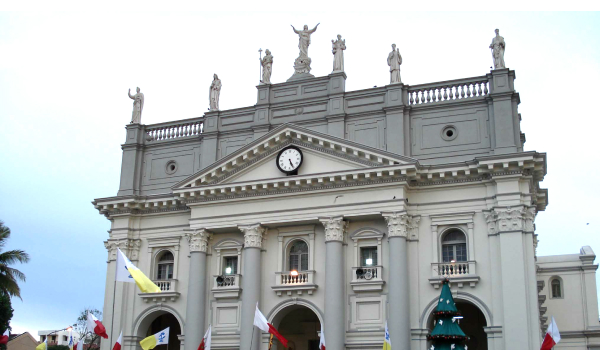
In a land area of 3,631.9 square kilometers, the diocesan territory includes three district such as Colombo, Kalutara and Gampaha. Colombo is the commercial capital of Sri Lanka.The name Colombo is derived from Sinhala name Kola-amba-thota which means "harbour with leafy mango trees." The Archdiocese of Colombo, is situated on the Western seaboard of the Island. Colombo Archdiocese is adjacent to Chilaw in the North, Kurunegala in the north west, Galle in the South and Kandy in the Central.
Colombo is a multi-ethnic, multi-cultural city. The population of Colombo is a mix of Sinhalese, Muslims,Moors and Tamils. Colombo is the most populated city in the country.
The standard Sinhala and Tamil languages are in use.
Colombo was known to Roman, Arab, and Chinese traders more than 2,000 years ago. Muslims settled in Colombo in the 8th century mostly because of the port that helped their business and controlled much of the trade between the Sinhalese kingdoms and the outside world. Mostly throughout the history the city has been a port city. Colombo port is one of the busiest ports in Asia.
Even today, the influence of the Portuguese, Dutch and British is clearly visible in Colombo 's architecture, names, clothing and food. Colombo is home to some of the island's top schools and a university.
Christianity was introduced in the diocesan territory by the Franciscans in 1518 and the religion spread rapidly, the town and the surrounding districts were soon erected into a diocese.
Sri Lanka remained under Goa's jurisdiction until in 1558 the diocese of Cochin was established and the island became part of that diocese, which position continued for 275 years until in 1834 Sri Lanka became an ecclesiastical territory by itself, a vicariate apostolic.This happened on Dec. 3, 1834.
The religious orders that were engaged in missionary work in the Portuguese period (from 1505 to1658), the Franciscans, Jesuits, Dominicans and Augustinians, had their main residence in Colombo. It was in Colombo, too that the Franciscans had their chief College, the College of St. Anthony, and the Jesuits their own college which was the foremost educational institution in the island at the time.
In the Dutch period (from 1685 to 1798), when the Church was being persecuted, Father Joseph Vaz, who came to the rescue of Lanka's Catholics, made Kandy the centre of his operations, from where he went again and again on missionary tours throughout the country.
Colombo assumed importance as the headquarters of the Church in Sri Lanka, when in 1834 (as already earlier mentioned) the island was detached from the diocese of Cochin and constituted as a vicariate apostolic, and the Indian Oratorian, Vicente do Rosayro, was appointed in 1838 as the first Vicar Apostolic of Sri Lanka.
On Sept. 17, 1847 the Vicariate Apostolic of Ceylon was divided into two Vicariates Apostolic, namely Colombo and Jaffna, with Vicar Apostolic Christopher Bonjean as the first ordinary of the Colombo territory.
When the hierarchy was established in Sri Lanka in 1887, Colombo became an archdiocese, with Jaffna and Kandy as its suffragan dioceses, and Christopher Bonjean, Colombo's Vicar Apostolic, became the first Archbishop of Colombo.
In 1893 the Eastern Province was separated from Jaffna diocese to become the new diocese of Trincomalee, and the Southern and Sabaragamuwa Provinces were detached from the archdiocese to form the diocese of Galle. Both the new dioceses were entrusted to the Jesuits. The North Western Province, which till now had been part of the diocese of Jaffna, was given to the archdiocese. This position remained till the North Western Province was made a separate diocese, the diocese of Chilaw, in 1939, with an Oblate priest, Edmund Peiris, as its first bishop.
After Christopher Bonjean, the next four Archbishops were all French Oblates like himself: Andrew Melizan (1893-1905), Antony Coudert (1905-1929), Peter Marque (1930-1937) and John Mary Masson (1938-1947). The next Archbishop too was an Oblate, but for the first time he was a Sri Lankan, Thomas Benjamin Cooray, who became also, in 1965, the first Sri Lankan Cardinal.
His episcopate, of nearly thirty years (1947-1976) has been the longest in the archdiocese.
After nearly a century of administration of the diocese by Oblates, a diocesan priest became its head for the first time when Archbishop Nicholas Marcus Fernando succeeded Cardinal Cooray in 1977.
According to the last census the total population of the archdiocese is 6,134,642 of whom 672,149 are Catholics. There are 324 churches and chapels. The Cathedral of St. Lucia, a fine building in the Renaissance style, can accomodate 6000 people. Many charitable institutions in the archdiocese, and many educational institutions of the archdiocese are in the hands of religious congregations.
The towns are managed by municipalities. The villages and small towns are administered by elected local bodies.
The diocesan area is well connected by roads and railways. The airport is at Katunayake in Colombo.
Colombo 's climate is fairly temperate all throughout the year. During the month of April the temperature averages around 35 degrees Celsius (95 degrees Fahrenheit). The only major change in the Colombo weather occurs during the monsoons from May to August and October to January, this is the time of year where heavy rains can be expected. Even though during the day time no severe drop in temperature takes place, the nights could be very chilly closer to the coast.
Government and private operators provide extensive telecommunication facilities in the diocesan area.
Colombo's topography is a mix of flat and marshy land. The East, and South East areas are bordered by marshy land. The city has many canals and the Beira Lake in the heart of the city. North and the North-East borders of the city flows the Kelani River. The river meets the sea in part of the city known as the Modera in Sinhala which literally means Delta.
91.4% is the literacy rate in the diocesan territory.